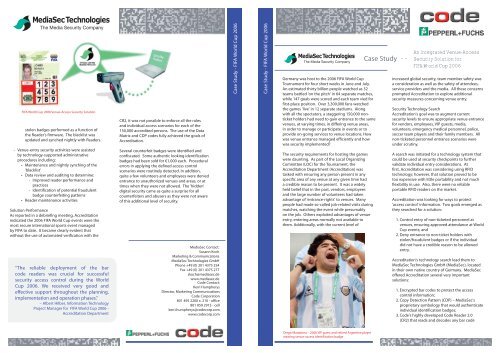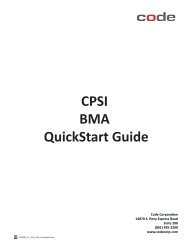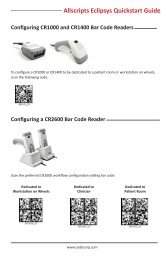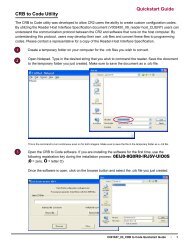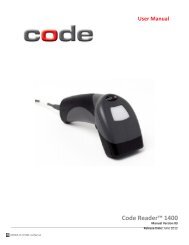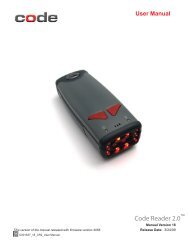FIFA World Cup Case Study - Code Corporation
FIFA World Cup Case Study - Code Corporation
FIFA World Cup Case Study - Code Corporation
Create successful ePaper yourself
Turn your PDF publications into a flip-book with our unique Google optimized e-Paper software.
<strong>FIFA</strong> <strong>World</strong> <strong>Cup</strong> 2006 Venue-Access Security Solution<br />
stolen badges performed as a function of<br />
the Reader's firmware. The blacklist was<br />
updated and synched nightly with Readers.<br />
- Venue-entry security activities were assisted<br />
by technology-supported administrative<br />
procedures including:<br />
• Maintenance and nightly synching of the<br />
'blacklist'<br />
• Data review and auditing to determine:<br />
- Improved reader performance and<br />
practices<br />
- Identification of potential fraudulent<br />
badge counterfeiting patterns<br />
• Reader maintenance activities<br />
Solution Performance<br />
As reported in a debriefing meeting, Accreditation<br />
indicated the 2006 <strong>FIFA</strong> <strong>World</strong> <strong>Cup</strong> events were the<br />
most secure international sports event managed<br />
by <strong>FIFA</strong> to date. It became clearly evident that<br />
without the use of automated verification with the<br />
“The reliable deployment of the bar<br />
code readers was crucial for successful<br />
security access control during the <strong>World</strong><br />
<strong>Cup</strong> 2006. We received very good and<br />
effective support throughout the planning,<br />
implementation and operation phases.”<br />
– Albert Hilber, Information Technology<br />
Project Manager for <strong>FIFA</strong> <strong>World</strong> <strong>Cup</strong> 2006 -<br />
Accreditation Department<br />
CR2, it was not possible to enforce all the rules<br />
and individual access scenarios for each of the<br />
150,000 accredited persons. The use of the Data<br />
Matrix and CDP codes fully achieved the goals of<br />
Accreditation.<br />
Several counterfeit badges were identified and<br />
confiscated. Some authentic looking identification<br />
badges had been sold for €1,000 each. Procedural<br />
errors in applying the defined access control<br />
scenarios were routinely detected. In addition,<br />
quite a few volunteers and employees were denied<br />
entrance to unauthorized venues and areas, or at<br />
times when they were not allowed. The 'hidden'<br />
digital security came as quite a surprise for all<br />
counterfeiters and abusers as they were not aware<br />
of this additional level of security.<br />
MediaSec Contact:<br />
Susann Koch<br />
Marketing & Communications<br />
MediaSec Technologies GmbH<br />
Phone +49 (0) 201 4375 254<br />
Fax +49 (0) 201 4375 277<br />
skoch@mediasec.de<br />
www.mediasec.de<br />
<strong>Code</strong> Contact:<br />
Kerri Humpherys<br />
Director, Marketing Communications<br />
<strong>Code</strong> <strong>Corporation</strong><br />
801 495 2200 x. 210 - office<br />
801 859 2913 - cell<br />
kerri.humpherys@codecorp.com<br />
www.codecorp.com<br />
<strong>Case</strong> <strong>Study</strong> - <strong>FIFA</strong> <strong>World</strong> <strong>Cup</strong> 2006<br />
<strong>Case</strong> <strong>Study</strong> - <strong>FIFA</strong> <strong>World</strong> <strong>Cup</strong> 2006<br />
Germany was host to the 2006 <strong>FIFA</strong> <strong>World</strong> <strong>Cup</strong><br />
Tournament for four short weeks in June and July.<br />
An estimated thirty billion people watched as 32<br />
teams battled 'on the pitch' in 64 separate matches,<br />
while 147 goals were scored and each team vied for<br />
first-place position. Over 3,300,000 fans watched<br />
the games 'live' in 12 separate stadiums. Along<br />
with all the spectators, a staggering 150,000 nonticket<br />
holders had need to gain entrance to the same<br />
venues, at varying times, in differing venue areas,<br />
in order to manage or participate in events or to<br />
provide on-going services to venue locations. How<br />
was venue entrance managed efficiently and how<br />
was security implemented?<br />
The security requirements for hosting the games<br />
were daunting. As part of the Local Organizing<br />
Committee (LOC) for the Tournament, the<br />
Accreditation Department (Accreditation) was<br />
tasked with ensuring any person present in any<br />
specific area of any venue at any given time had<br />
a credible reason to be present. It was a widely<br />
held belief that in the past, vendors, employees<br />
and the large number of volunteers had taken<br />
advantage of 'entrance-rights' to venues. Many<br />
people had made so-called job-related visits during<br />
matches, watching the event while presumably<br />
on the job. Others exploited advantages of venue<br />
entry, entering areas normally not available to<br />
them. Additionally, with the current level of<br />
Diego Maradona – 2006 VIP guest and retired Argentine player<br />
wearing venue-access identification badge<br />
<strong>Case</strong> <strong>Study</strong> - -<br />
An Integrated Venue-Access<br />
Security Solution for<br />
<strong>FIFA</strong> <strong>World</strong> <strong>Cup</strong> 2006<br />
increased global security, team member safety was<br />
a consideration as well as the safety of attendees,<br />
service providers and the media. All these concerns<br />
prompted Accreditation to explore additional<br />
security measures concerning venue entry.<br />
Security Technology Search<br />
Accreditation's goal was to augment current<br />
security levels to ensure appropriate venue entrance<br />
for vendors, employees, VIP guests, media,<br />
volunteers, emergency medical personnel, police,<br />
soccer team players and their family members. All<br />
non-ticketed personnel entrance scenarios were<br />
under scrutiny.<br />
A search was initiated for a technology system that<br />
could be used at security checkpoints to further<br />
validate individual entry considerations. At<br />
first, Accreditation was considering using RFID<br />
technology; however, that solution proved to be<br />
too expensive with little portability and not much<br />
flexibility in use. Also, there were no reliable<br />
portable RFID readers on the market.<br />
Accreditation was looking for ways to protect<br />
'access control' information. Two goals emerged as<br />
they searched for a solution:<br />
1. Control entry of non-ticketed personnel at<br />
venues, ensuring approved attendance at <strong>World</strong><br />
<strong>Cup</strong> events; and<br />
2. Deny entrance to non-ticket holders with<br />
stolen/fraudulent badges or if the individual<br />
did not have a credible reason to be allowed<br />
entry.<br />
Accreditation's technology search lead them to<br />
MediaSec Technologies GmbH (MediaSec), located<br />
in their own native country of Germany. MediaSec<br />
offered Accreditation several very important<br />
solutions:<br />
1. Encrypted bar codes to protect the access<br />
control information;<br />
2. Copy Detection Pattern (CDP) – MediaSec's<br />
proprietary symbology that would authenticate<br />
individual identification badges;<br />
3. <strong>Code</strong>'s highly developed <strong>Code</strong> Reader 2.0<br />
(CR2) that reads and decodes any bar code
<strong>Case</strong> <strong>Study</strong> - <strong>FIFA</strong> <strong>World</strong> <strong>Cup</strong> 2006<br />
type with Dynamic Optimization Technology,<br />
a proprietary bar code reading performance<br />
enhancement tool that quickly adapts Reader<br />
performance; and,<br />
4. Software to manage and support venue security<br />
process operations, auditing and counterfeit<br />
detection of badges.<br />
The bar code symbology selected to protect the<br />
access control information was a two-dimensional<br />
“When MediaSec was first approached<br />
by Accreditation, I realized we were<br />
being given a rare opportunity to test<br />
our technology on a large scale. Our<br />
security technology is unchallenged in<br />
the marketplace and clearly we had a<br />
viable technology-based answer to the<br />
need.”<br />
– Dr. Jan Vorbrüggen, Manager of Business<br />
Development at MediaSec<br />
Data Matrix code. This code could hold all the<br />
specific information for venues, dates and times the<br />
badge holder would be allowed entrance.<br />
MediaSec's proprietary digital security technology<br />
– CDP – is designed specifically to limit<br />
counterfeiting or copying practices. A CDP symbol<br />
has the appearance of a two-dimensional bar code<br />
with intentional information loss. The fragmented<br />
symbol is virtually impossible to duplicate,<br />
ultimately providing the desired protection<br />
against counterfeiting. In addition, the process<br />
of encoding and decoding CDP can incorporate<br />
the use of a secret key code, adding an additional<br />
layer of security to the identification process.<br />
CDP provided the counterfeiting protection<br />
Accreditation was seeking.<br />
These two codes would be read and decoded by<br />
the CR2. Uniquely developed CR2 firmware and<br />
PC-based computer software would accomplish<br />
an electronic review against a 'blacklist' of known<br />
fraudulent or stolen identification badges and an<br />
authenticity check of the CDP code.<br />
After a test was completed of the barcode access<br />
control technology at an unrelated athletic event,<br />
Accreditation was satisfied that an appropriate<br />
solution had been identified. Information was<br />
exchanged and the project was initiated.<br />
Partnered Solution<br />
MediaSec is a value-added reseller for<br />
Pepperl+Fuchs (P+F) – a leading developer and<br />
manufacturer of electronic sensors and components<br />
for the global automation market. P+F is a worldwide<br />
distributor of <strong>Code</strong> Products including the<br />
CR2, the wireless bar code Reader able to read and<br />
decode MediaSec's proprietary CPD symbology as<br />
well as the Data Matrix codes used in the <strong>World</strong><br />
<strong>Cup</strong> solution. All three parties worked together<br />
to provide a flexible and integrated hardware/<br />
software solution for Accreditation.<br />
MediaSec solutions included:<br />
- Tailored Reader Firmware (developed using<br />
<strong>Code</strong>'s Software Development Kit) integrated<br />
with current <strong>Code</strong> Reader Firmware to<br />
accomplish the following:<br />
• Reading, analysis and authentication of<br />
CDP to verify badge authenticity<br />
• Reading and decrypting of Data Matrix bar<br />
code to manage access control<br />
• Comparison of badge information to<br />
'blacklist' to identify counterfeit or stolen<br />
badges<br />
- PC-based process management software, to<br />
manage:<br />
• Configuration of Readers indicating<br />
authorizations for venue, date and time<br />
• Blacklist maintenance<br />
• Check-in/check-out process of Readers to<br />
security personnel<br />
• Firmware updates to multiple Readers at<br />
once<br />
• Verification at completion of Reader<br />
updates<br />
- Reader Optic 'nose' to optimize Reader position<br />
and CDP code magnification<br />
<strong>Code</strong> products (as sold and supported by P+F)<br />
included:<br />
- 300 CR2 Bar code Readers, Handles and<br />
Batteries<br />
- 27 Two-Bay Battery Chargers<br />
- <strong>Code</strong> Reader Firmware enabling reading and<br />
decrypting of Data Matrix and CDP bar codes<br />
Venue Entry Process<br />
The venue entry process at security check points<br />
for the 2006 <strong>FIFA</strong> <strong>World</strong> <strong>Cup</strong> Tournament included<br />
several major components:<br />
- An individual requesting venue entrance with<br />
an identification badge containing:<br />
• Official event branding<br />
• Badge holder's name<br />
• Color digital photo<br />
• Data Matrix code containing information<br />
regarding the dates, times, venues and<br />
areas of access for that individual<br />
• CDP code used to authenticate the badge<br />
• 'Large' numbers to indicate approved venue<br />
Timeline<br />
January 2005<br />
January 2005<br />
April 2005<br />
May 2005<br />
May 2005<br />
May 2005<br />
June 2005<br />
October 2005<br />
November 2005<br />
November 2005<br />
December 2005<br />
December–April 2006<br />
March 2006<br />
May 2006<br />
May–June 2006<br />
June–July 2006<br />
area access<br />
• Stadium icons identifying approved venues<br />
• Additional physical security measures (e.g.,<br />
hologram)<br />
Note: To obtain an identification badge, each<br />
person had to register on-line and provide the<br />
requested information to accomplish a security<br />
clearance check. The individual would be<br />
notified by email if the security clearance was<br />
successful. The person then needed to report<br />
to one of several security offices at identified<br />
venues to obtain an identification badge.<br />
- A Security guard (with a CR2 Bar <strong>Code</strong> Reader)<br />
who:<br />
• Visually compared the digital photo on the<br />
identification badge to the person<br />
• Visually reviewed 'large numbers' and<br />
stadium icons on identification badge<br />
indicating approved venue access<br />
• Used the CR2 to read the Data Matrix<br />
<strong>Code</strong> and CDP code and waited for<br />
visual/audible verification before allowing<br />
Venue-access identification badge issued to all non-ticket holders<br />
Initial meeting of MediaSec and Accreditation<br />
Specification developed for Data Matrix code<br />
Data Matrix code testing<br />
Accreditation delivers ‘Letter of Intent’<br />
PC Software/Reader Firmware development<br />
Delivery of ‘beta’ Data Matrix code<br />
Successful test of unencrypted Data Matrix code<br />
MediaSec delivers Proposal (including CDP)<br />
Proposal accepted<br />
Software/Firmware integration<br />
Successful test of CDP and logistics<br />
Badge production testing<br />
Qualification review of hardware/software and processes<br />
Badge & Reader deployment begins at International Broadcast Center in Munich<br />
Deployed 300 CR2s to 14 locations<br />
<strong>World</strong> <strong>Cup</strong> Tournament: On-going support and on-site training<br />
“As partners, all three businesses<br />
worked together to provide a very<br />
unique solution for Accreditation. The<br />
integration of the hardware and software<br />
solutions utilizing several proprietary<br />
technologies was very successful.”<br />
– George Powell, President and<br />
CEO of <strong>Code</strong> <strong>Corporation</strong><br />
entrance:<br />
- Green LED light & two short beeps =<br />
Access permitted<br />
- Red LED light & one long beep = Access<br />
denied<br />
- Yellow LED light & one short beep =<br />
Scan second badge issued to service<br />
providers/employees only and review<br />
Green or Red LEDs (see previous)<br />
Note: Verification also included a check<br />
against a 'blacklist' of known fraudulent or<br />
<strong>Case</strong> <strong>Study</strong> - <strong>FIFA</strong> <strong>World</strong> <strong>Cup</strong> 2006


